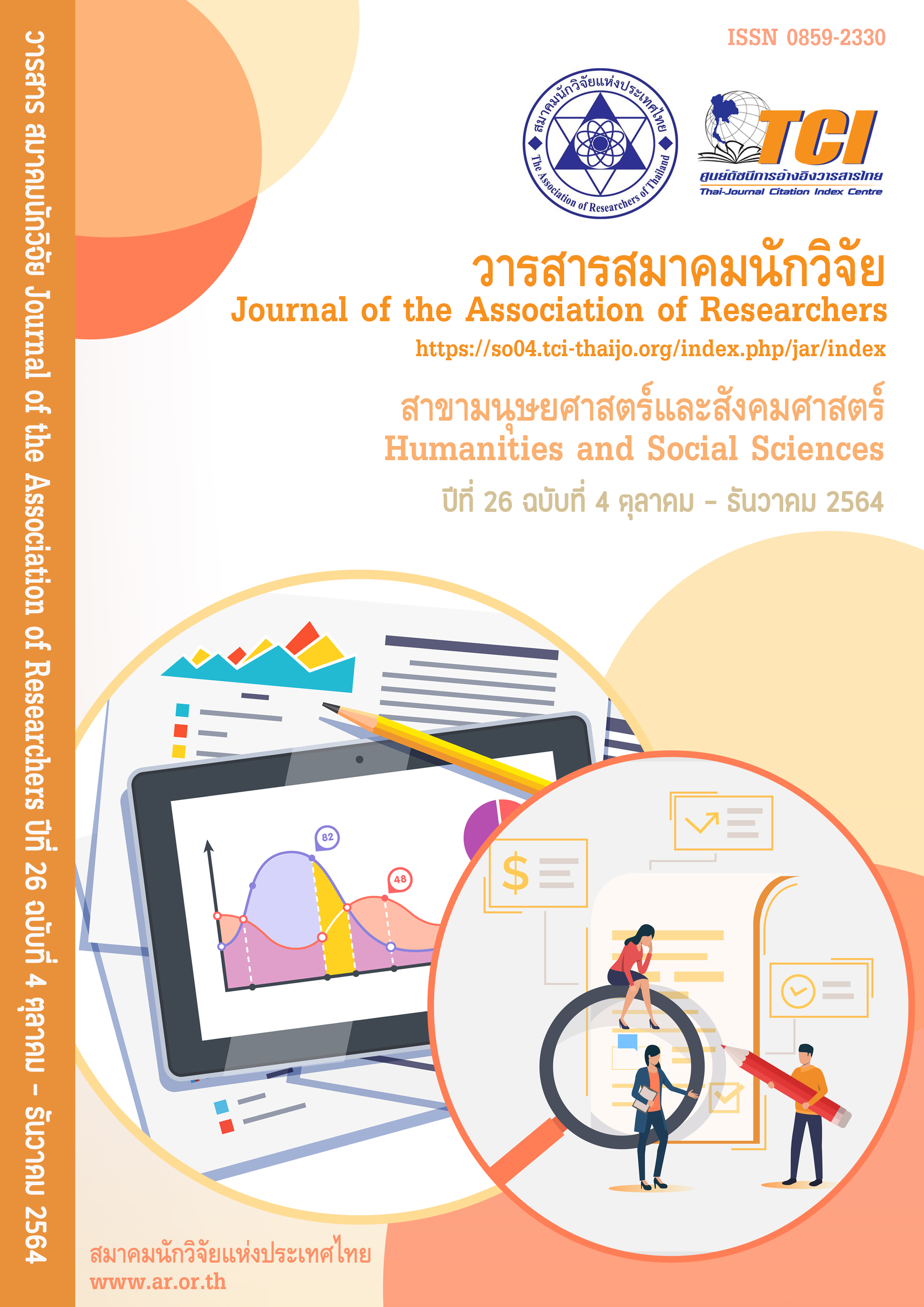Enhancement of Anger Control of Adolescent Students Through Group Counseling
Main Article Content
Abstract
The objectives of this research were as follows to 1) to study the anger control of adolescent students, and 2) to compare the anger control of adolescent students before and after participation in group counseling. The research was divided into two phases. The first phase was to study anger control. The samples consisted of 333 adolescent students selected by simple random sampling. The second phase was the enhancement of anger control, eight adolescents selected by adolescent students with anger control scores ranging from in the 25th percentile and below volunteered to participate and used simple random sampling. The research instruments included the following: 1) an anger control test with a reliability of .76; and 2) group counseling to strengthen the anger control of adolescent students. The statistics used to analyze the data were mean standard deviation and Paired Sample T-Test statistic dependent t-test. The results of this research were as follows: 1) Overall the anger control of adolescent students as a whole was at a good level and thinking about the causes of anger and their responses to anger were at a very good level as for the emotional self-control and anger suppression were at a good level, and 2) After joining a group counseling for anger control adolescent students had different the anger control average scores before joining a group counseling and after participating in group counseling and at a statistically significant level of .05. This result indicated that group counseling increased the anger control of adolescent students.
Article Details
บทความที่ปรากฏในวารสารนี้ เป็นความรับผิดชอบของผู้เขียน ซึ่งสมาคมนักวิจัยไม่จำเป็นต้องเห็นด้วยเสมอไป การนำเสนอผลงานวิจัยและบทความในวารสารนี้ไปเผยแพร่สามารถกระทำได้ โดยระบุแหล่งอ้างอิงจาก "วารสารสมาคมนักวิจัย"
References
กิตติศักดิ์ รักษาชาติ. (2559). ผลของการให้คำปรึกษากลุ่มตามทฤษฎีพฤติกรรมบำบัดผ่านการรู้คิดที่มีต่อการแสดงความโกรธของนักเรียนระดับชั้นมัธยมศึกษาตอนปลายโรงเรียนเอกชนแห่งหนึ่งในจังหวัดปทุมธานี. (ปริญญานิพนธ์ปริญญามหาบัณฑิต). มหาวิทยาลัยรามคำแหง, กรุงเทพฯ.
ทัศไนย วงศ์สุวรรณ. (2542). ผลของการปรึกษาเชิงจิตวิทยาแบบกลุ่มตามแนว พิจารณาเหตุผล อารมณ์และพฤติกรรมต่อความโกรธของนักเรียนวัยรุ่น. (ปริญญาศิลปศาสตร์มหาบัณฑิต). จุฬาลงกรณ์มหาวิทยาลัย, กรุงเทพฯ.
นันทนา วงษ์อินทร์. (2546). การให้คำปรึกษาแบบกลุ่ม. กรุงเทพฯ: ภาควิชาการแนะแนวและจิตวิทยาการศึกษา คณะศึกษาศาสตร์ มหาวิทยาลัยศรีนครินทรวิโรฒ.
พนม เกตุมาน. (2550). พัฒนาการของวัยรุ่น. สืบค้นจาก https://www.psyclin.co.th/new_page_56.htm
พยุงศักดิ์ ฝางแก้ว. (2558). ผลของการจัดการความโกรธที่เน้นการปรับความคิดต่อพฤติกรรมก้าวร้าวของผู้ป่วยจิตเภท. (ปริญญานิพนธ์ปริญญามหาบัณฑิต). จุฬาลงกรณ์มหาวิทยาลัย, กรุงเทพฯ.
พัชราภรณ์ ศรีสวัสดิ์. (2561). การประยุกต์ใช้ทฤษฎีและเทคนิคการให้คำปรึกษาเด็กและวัยรุ่น. กรุงเทพฯ: มหาวิทยาลัยศรีนครินทรวิโรฒ.
ลักษณา พงษ์ภุมมา. (2560). ปัญหาของวัยรุ่นในสังคมไทย. สืบค้นจาก http://164.115.41.60/knowledge/?p=436
สมโภชน์ เอี่ยมสุภาษิต. (2556). ทฤษฎีและเทคนิคการปรับพฤติกรรม. (พิมพ์ครั้งที่ 8). กรุงเทพฯ: จุฬาลงกรณ์มหาวิทยาลัย.
สวนีย์ สุขเจริญ. (2553). ผลของการให้คำปรึกษากลุ่มเพื่อจัดการความโกรธของวัยรุ่น. ปริญญานิพนธ์ (กศ.ม. (จิตวิทยาการแนะแนว)) มหาวิทยาลัยศรีนครินทรวิโรฒ, 2553
สากล คำภูมี. (2548). ผลของการใช้โปรแกรมความฉลาดอารมณ์ต่อความโกรธของนักเรียนชั้นมัธยมศึกษาปีที่ 2 จังหวัดชลบุรี (ปริญญานิพนธ์ปริญญามหาบัณฑิต). มหาวิทยาลัยบูรพา, ชลบุรี
อรัญญา งามระยับ. (2532). การศึกษาพฤติกรรมความโกรธของนักเรียนชั้นประถมศึกษาปีที่ 6 โรงเรียนอนุบาลลพบุรี. (ปริญญานิพนธ์ปริญญามหาบัณฑิต). มหาวิทยาลัยศรีนครินทรวิโรฒ, กรุงเทพฯ.
อัจฉรา สกุนตนิยม. (2545, มกราคม – กุมภาพันธ์). มารู้จักความโกรธกันเถอะ. วารสารหมออนามัย, 11(4), 36-37.
อวยชัย โรจนนิรันดร์กิจ. (2547). การจัดการความโกรธ. สืบค้นจาก http://www.psychiatry.or.th/2010/journal06-3.php?l=th
Burney; & Kromrey (2001, June). Initial Development and Score Validation of the Adolescent Anger Rating Scale. Educationl and Psychological Measurement, 6(3).
Spielberger, C. D. (1988). State-trait Anger Expression Inventory. Florida: Psychological Assessment Resources.
Yamane, T. (1973). Statistic: an introductory Analysis. (3rd). New York: Haper and Row Publications.


